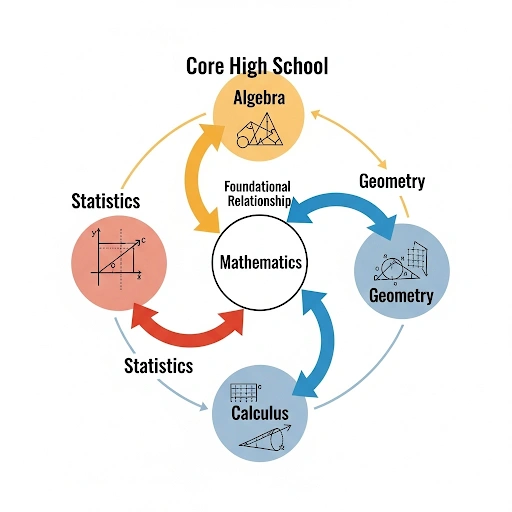Mathematics can inspire both fascination and dread, from elegant equations to confusing symbols. Mastering high school math is essential not only for academics but for life skills. Using SAT vocabulary flashcards alongside math practice strengthens comprehension and retention, turning complex concepts into manageable learning. Regular use of SAT vocabulary flashcards supports problem-solving and strategic thinking. By integrating SAT vocabulary flashcards into your routine, frustration transforms into understanding, helping you thrive and even enjoy high school math.
High school math lays the foundation for college and future careers, from algebra to calculus, where each concept builds on the last. Using SAT vocabulary flashcards alongside your studies can reinforce understanding and support retention of key terms. Falling behind, even slightly, can create hurdles, but integrating SAT vocabulary flashcards with consistent practice helps maintain steady progress. With the right approach, including reviewing SAT vocabulary flashcards regularly, students can boost their problem-solving skills and achieve their full potential. Effective high school learning strategies, combined with tools like SAT vocabulary flashcards, make mastering math an attainable and even enjoyable goal.
- What is Math Learning in High School with SAT Vocabulary Flashcards?
- Why Mastering Math Matters: Benefits for High School Students
- How to Master Math: Core Features & Effective Strategies
- The Journey of a Successful High School Math Student
- Common Mistakes High School Students Make in Math to Avoid
- Expert Tips and Best Practices for High School Math Success
- FAQ Section
- Conclusion
What is Math Learning in High School with SAT Vocabulary Flashcards?
Math learning in high school goes beyond memorizing formulas and procedures. Incorporating SAT vocabulary flashcards into your study routine can help reinforce key mathematical terms and concepts. Developing a deep understanding of math requires logical reasoning and problem-solving, and using SAT vocabulary flashcards regularly supports retention of definitions and principles. High school math often introduces abstract topics, making critical thinking essential, and reviewing SAT vocabulary flashcards alongside lessons can make applying theories to diverse problems much easier. By combining study habits with SAT vocabulary flashcards, students can strengthen both comprehension and practical skills effectively.
In high school, students typically progress through a series of increasingly complex subjects:
- Algebra I & II: Focuses on linear equations, inequalities, functions, polynomials, and systems of equations, building the language of mathematics.
- Geometry: Explores shapes, sizes, positions, and properties of space, emphasizing logical proofs and spatial reasoning.
- Pre-Calculus/Trigonometry: Prepares students for calculus by delving into advanced functions, trigonometry, and analytical geometry.
- Calculus (AP/IB or standard): Introduces concepts of limits, derivatives, and integrals, which are fundamental to engineering, physics, economics, and other STEM fields.
- Statistics & Probability: Focuses on data analysis, interpretation, and making predictions, crucial skills in our data-driven world.
High school math extends beyond the classroom, and SAT vocabulary flashcards can reinforce essential concepts and terminology. In 2025 and beyond, a strong math foundation, supported by SAT vocabulary flashcards, is vital for careers in AI, data science, engineering, finance, and creative fields. Key skills like algorithmic thinking, statistical analysis, and logical reasoning, enhanced through high school math and SAT vocabulary flashcards, give students a competitive edge. Using SAT vocabulary flashcards alongside consistent study transforms today’s effort into tomorrow’s opportunities.

Why Mastering Math Matters: Benefits for High School Students
The benefits of mastering mathematics in high school go far beyond good grades. It’s about building a robust mental toolkit that serves you throughout your life. Here’s why dedicating yourself to mastering mathematics is one of the smartest investments you can make:
- Enhanced Problem-Solving Skills: Math inherently teaches you how to break down complex problems into smaller, manageable steps. This analytical approach isn’t limited to equations; it’s a valuable skill applicable to challenges in any academic subject, career, or real-life situation. Whether you’re planning a budget or troubleshooting a technical issue, the logical framework learned in math is invaluable.
- Improved Critical Thinking and Logical Reasoning: Math demands precise thinking. You learn to identify patterns, evaluate arguments, and construct logical proofs. This rigorous training sharpens your critical thinking abilities, allowing you to assess information, make informed decisions, and avoid common fallacies.
- Foundation for STEM Careers: If you’re considering a future in science, technology, engineering, or mathematics (STEM), strong math skills are non-negotiable. From designing bridges to developing software, nearly all STEM fields are built upon advanced mathematical concepts. Early mastery in high school provides a distinct advantage for college-level courses and future professional success.
- Success in Standardized Tests: Standardized tests like the SAT and ACT heavily feature math sections. A solid grasp of high school math concepts directly translates to higher scores, which can significantly impact college admissions and scholarship opportunities. Consistent math study habits will make these sections less daunting.
- Financial Literacy: Basic mathematical understanding is crucial for managing personal finances, understanding investments, and making sound economic decisions. Concepts like percentages, interest rates, and financial modeling, often introduced or reinforced in high school math, are directly applicable to real-world financial planning.
- Boosted Confidence and Resilience: Tackling challenging math problems and eventually solving them builds immense self-confidence. Overcoming mathematical obstacles teaches you resilience and perseverance – qualities that are essential for tackling any difficult task, both inside and outside of academia. To deepen your understanding of how structured approaches can lead to success in various fields, you might find insights into agile methodologies helpful, even for personal goal setting: https://manukliar.com/agile-scrum-certification-tips-beginners/.
How to Master Math: Core Features & Effective Strategies
Effective math learning isn’t about innate genius; it’s about employing proven strategies consistently. Here are core features and strategies that will help you improve math skills and truly master the subject:
1. Active Learning, Not Passive Absorption
- Do Problems, Don’t Just Read Them: Math is a “doing” subject. You cannot learn it by simply watching your teacher or reading a textbook. Work through every example problem, solve every homework question, and actively engage with the material.
- Teach Others: Explaining a concept to a classmate is one of the most powerful ways to solidify your own understanding. If you can teach it, you truly know it.
- Ask “Why?”: Don’t just accept formulas or procedures. Ask why they work. Understanding the underlying logic and derivation will lead to deeper comprehension and better retention.
2. Consistent Practice is Key
- Daily Engagement: Short, consistent practice sessions are far more effective than long, infrequent cramming sessions. Aim for 20-30 minutes of math practice daily.
- Variety of Problems: Don’t just stick to the easy problems. Challenge yourself with a diverse range of problems, including word problems and those that require multiple steps or concepts. This builds versatility in your high school learning.
- Review Regularly: Math is cumulative. Regularly review previously learned topics to keep them fresh in your mind. This prevents knowledge gaps from forming as you progress to more complex material.
3. Understand, Don’t Just Memorize
- Concept Mapping: Create visual maps that connect different mathematical concepts. How does algebra relate to geometry? How do derivatives relate to rates of change? Seeing these connections helps build a holistic understanding.
- Visualize: For abstract concepts, try to visualize them. Graphing calculators and online tools like Desmos or GeoGebra can help you see functions, equations, and geometric figures in action, turning abstract ideas into tangible insights.
- Break Down Complex Problems: When faced with a daunting problem, don’t get overwhelmed. Break it into smaller, more manageable parts. Solve each part individually, then combine the solutions.
4. Utilize Available Resources
- Your Teacher: Your math teacher is your primary resource. Don’t hesitate to ask questions in class, attend office hours, or seek extra help. They are there to support your high school math success.
- Textbook and Online Resources: Your textbook is more than just a source of homework problems. Read the explanations, review examples, and use supplementary materials. Websites like Khan Academy, IXL, and Mathplanet offer free lessons, practice problems, and video tutorials that can complement your classroom learning.
- Study Groups: Collaborate with classmates. Explain concepts to each other, work through problems together, and challenge each other’s understanding. Diverse perspectives can often clarify confusing topics.
- Tutoring: If you’re consistently struggling with a particular concept or falling behind, consider seeking a tutor. Personalized guidance can make a significant difference.
5. Effective Note-Taking and Organization
- Organized Notes: Keep your notes clear, concise, and well-organized. Include definitions, formulas, and step-by-step examples. Use different colors or highlighting to emphasize key information.
- Error Log: Maintain an “error log” where you record problems you got wrong, why you got them wrong, and the correct solution. Review this log regularly to identify patterns in your mistakes and prevent repeating them.
- Manage Your Time: Allocate specific time slots in your study schedule for math. Consistency is key, and a structured approach ensures you don’t fall behind.

The Journey of a Successful High School Math Student
Let’s look at Sarah, a high school junior who initially found math daunting. She decided to combine her study routine with SAT vocabulary flashcards to strengthen her understanding of key concepts. Even when algebra and geometry felt like a foreign language, reviewing SAT vocabulary flashcards helped her internalize terms and problem-solving steps. Her grades gradually improved as she applied math strategies alongside SAT vocabulary flashcards for consistent practice. By using SAT vocabulary flashcards throughout her high school learning journey, Sarah gained confidence and reduced anxiety before each math test.
First, Sarah committed to active learning. Instead of just passively listening in class, she started taking meticulous notes, often integrating SAT vocabulary flashcards to reinforce her understanding of key terms. After class, she would review her notes and work through example problems, using SAT vocabulary flashcards as a reference to clarify concepts. Whenever she got stuck, Sarah turned to her SAT vocabulary flashcards to identify gaps and correct mistakes. This consistent, hands-on approach, combined with SAT vocabulary flashcards, allowed her to strengthen her math skills more effectively.
Next, she embraced consistent practice. Sarah downloaded a math practice app and paired it with SAT vocabulary flashcards to reinforce key concepts. Every evening, she dedicated 30 minutes to solving problems while occasionally reviewing SAT vocabulary flashcards to connect terminology with mathematical ideas. She didn’t avoid challenging problems, often referring to her SAT vocabulary flashcards when concepts felt tricky. When she got stuck, Sarah revisited her SAT vocabulary flashcards or asked her teacher the next day. This combination of active problem-solving and SAT vocabulary flashcards transformed her math study habits.
Sarah also learned the power of understanding over memorization. For complex geometry proofs, she used SAT vocabulary flashcards alongside her diagrams to connect terminology with the logical steps. In calculus, she watched animated videos and referenced SAT vocabulary flashcards to clarify abstract concepts. Explaining problems to her younger brother, she would often use examples from her SAT vocabulary flashcards, reinforcing both her math skills and retention. Even when tackling challenging exercises, Sarah kept her SAT vocabulary flashcards nearby, integrating them naturally into her study routine.
She made full use of available resources. Sarah started attending her teacher’s optional lunch-time help sessions twice a week. She joined a study group with two friends who were also committed to improving their math skills. They would quiz each other, explain different ways to approach problems, and sometimes even race to solve a set of equations, turning practice into a fun, competitive activity. When a topic like logarithms proved particularly tricky, she supplemented her learning with Khan Academy videos, finding alternative explanations that resonated with her.
Finally, Sarah adopted effective note-taking and organization. She bought a dedicated binder for math, keeping all her notes, homework, and quizzes neatly organized. Crucially, she started an “error journal.” Every time she made a mistake on a quiz or homework, she’d write down the original problem, her incorrect solution, the correct solution, and a brief explanation of *why* she made the error. Before every test, she’d review this journal, ensuring she didn’t repeat the same mistakes.
Over a few months, Sarah’s confidence soared. Her grades steadily improved, and she found herself actually enjoying the challenge of math. She realized that mastering mathematics wasn’t about being “naturally good” at it, but about consistent effort, smart strategies, and a willingness to learn from every mistake.

Common Mistakes High School Students Make in Math to Avoid
While many students aspire to master math fast, certain pitfalls can hinder progress. Avoiding these common mistakes is as important as implementing effective strategies:
- Procrastination: Math is cumulative. Putting off homework or studying means building a shaky foundation. Each new concept builds on the last, so once you fall behind, it becomes exponentially harder to catch up. Daily, consistent engagement prevents this snowball effect.
- Rote Memorization Without Understanding: Simply memorizing formulas without understanding their derivation or application is a recipe for disaster. While some formulas need to be known, true high school learning in math involves comprehending *why* a formula works and *when* to use it.
- Not Showing Work: Many students skip steps, especially if they can do calculations in their head. However, showing your work is crucial. It helps you track your thought process, identify errors, and often earns partial credit even if the final answer is incorrect. It also reinforces the step-by-step problem-solving approach.
- Ignoring Mistakes: Mistakes are not failures; they are learning opportunities. Many students simply look at the correct answer to a problem they got wrong and move on. Instead, analyze *why* you made the mistake. Was it a conceptual misunderstanding, a calculation error, or a misreading of the problem? Learning from errors is vital for improving math skills.
- Lack of Practice: Math is a skill, and like any skill, it requires consistent practice to maintain and improve. Relying solely on classroom instruction or homework assigned by the teacher is often insufficient. Proactive practice solidifies concepts.
- Fear of Asking Questions: Many students are afraid to ask questions in class, fearing they might look “dumb” or hold up the class. This is a significant barrier to high school math success. Chances are, if you have a question, several of your classmates do too. Asking for clarification helps everyone.
- Over-reliance on Calculators: While calculators are essential tools, over-reliance on them for basic calculations can hinder your mental math abilities and conceptual understanding. Use them to verify answers, not to avoid understanding the process.
- Cramming Before Tests: Math cannot be crammed. Its cumulative nature means that last-minute studying will likely lead to superficial knowledge that quickly fades. Consistent, spaced practice is far more effective for long-term retention.
Myth-Busting: “I’m Just Not a Math Person”
This is perhaps the most damaging misconception. The idea that some people are “math people” and others aren’t is largely a myth. While individuals may have different learning styles or initial aptitudes, success in math is predominantly a result of effort, effective strategies, and a growth mindset. Anyone can master mathematics with the right approach.
Expert Tips and Best Practices for High School Math Success
Beyond avoiding common pitfalls, here are some actionable expert math tips and best practices to accelerate your journey to high school math success:
- Master the Fundamentals (and Revisit Them): “Mathematics is like building a wall,” says veteran math teacher Mr. Harrison. “If the bricks at the bottom aren’t solid, the whole structure will eventually crumble.” Before moving to advanced topics, ensure you have a rock-solid understanding of fundamental concepts from previous grades. If you’re struggling with algebra, revisit pre-algebra. If calculus is confusing, go back to pre-calculus and functions. Don’t be ashamed to review.
- Pre-Read Chapters: Before your teacher introduces a new topic, skim the chapter in your textbook. This primes your brain, making the lecture easier to follow and helping you identify areas you anticipate needing more clarification on.
- Utilize Online Tutors and Explanations: Sometimes, a concept just clicks differently when explained by someone else. Websites like Khan Academy (as previously mentioned: https://www.khanacademy.org/), Coursera, or even specific YouTube channels (e.g., Organic Chemistry Tutor for math, PatrickJMT) offer alternative explanations and a wealth of practice problems. These resources can be invaluable for reinforcing high school learning.
- Create Your Own Practice Problems: Once you feel confident with a concept, try creating your own practice problems. This forces you to think about the structure of the problem and the application of the concept from a deeper perspective, enhancing your math study habits.
- Visualize with Graphing Tools: Tools like Desmos or GeoGebra aren’t just for advanced math; they can visualize algebraic functions, geometric transformations, and statistical distributions. Seeing the visual representation of equations can drastically improve understanding, especially for visual learners.
- Connect Math to Real Life: Try to find real-world applications for the math you’re learning. How is trigonometry used in architecture? Where do you see exponential growth in economics? Connecting abstract concepts to tangible examples makes them more relevant and easier to remember.
- Embrace Productive Struggle: It’s okay to struggle with a problem. In fact, struggling and eventually figuring it out is where the deepest learning happens. Don’t immediately look up the answer or ask for help the moment you get stuck. Give yourself time to wrestle with the problem. This “productive struggle” builds resilience and genuine problem-solving capacity, key elements of SAT vocabulary flashcards.
- Maintain a Growth Mindset: Believe that your mathematical abilities can grow and improve with effort. Avoid self-defeating thoughts like “I’m bad at math.” Instead, focus on the process of learning and improving. Celebrate small victories and view challenges as opportunities for growth.
- Prioritize Sleep and Breaks: Your brain needs rest to consolidate learning. Ensure you’re getting enough sleep, especially before tests. Also, take short breaks during long study sessions to avoid burnout and maintain focus.
- Understand Your Learning Style: Are you a visual learner? An auditory learner? A kinesthetic (hands-on) learner? Tailor your study methods to your preferred style. Visual learners might benefit from diagrams and videos, while kinesthetic learners might need to work through more problems physically.
- Consider Early Exposure to Next-Level Concepts: If you’ve mastered your current high school math topics and are looking for a challenge, consider exploring introductory concepts of the next level (e.g., basic linear algebra or discrete math) through online resources. This proactive approach can make future courses easier.
FAQ Section
Q: How can I improve my math grades quickly?
A: Rapid improvement often comes from focused effort on areas of weakness. Start by actively reviewing all your past mistakes, understanding why they occurred. Then, dedicate consistent daily practice (20-30 minutes) to those specific topics. Seek immediate clarification from your teacher or online resources whenever you encounter a new concept you don’t fully grasp. Consistent daily effort is more impactful than last-minute cramming.
Q: Is it true that some people are just naturally better at math?
A: While some individuals might grasp concepts faster initially, the idea of being “naturally good” at math is largely a myth. Success in mathematics is primarily driven by effort, persistence, and the application of effective study strategies. Anyone can improve their math skills with dedication and the right approach. Focus on developing a growth mindset rather than believing in fixed abilities.
Q: What if I don’t understand what my teacher is explaining in class?
A: This is a common experience. First, try asking a clarifying question in class. If you’re still confused, make a note of the specific concept and approach your teacher after class or during office hours. Additionally, utilize online resources like Khan Academy or YouTube tutorials which might explain the same concept in a different way that resonates with your learning style. Don’t let confusion linger.
Q: How important is math for future careers, especially if I’m not pursuing a STEM field?
A: Math is incredibly important, even outside of traditional STEM fields. It develops critical thinking, problem-solving, and logical reasoning skills that are valuable in almost every profession. From understanding financial reports in business to analyzing data in social sciences, and even in creative fields like design and music (think patterns and proportions), a strong mathematical foundation provides a significant advantage. Its importance in sectors like cybersecurity, which relies on complex mathematical algorithms, is also growing, as discussed in this resource about secure SaaS tools: secure saas tools.
Q: How much math practice should I do every day?
A: Consistency is more important than duration. Aim for at least 20-30 minutes of focused math practice every day. This daily engagement keeps the material fresh, reinforces concepts, and prevents you from falling behind. On days leading up to a test, you might increase this time.
Q: Should I use a calculator for every math problem?
A: No. While calculators are useful for complex computations and verifying answers, over-reliance can hinder your fundamental understanding and mental math abilities. Use calculators when necessary (e.g., for large numbers or specific functions), but ensure you can still perform basic operations and understand the underlying mathematical processes without one. Develop your own problem-solving skills first.
Q: What’s the best way to study for a big math exam?
A: The best approach is consistent study leading up to the exam, not just cramming. Review all your notes, especially your error log. Work through a variety of practice problems, including past quizzes and tests, under timed conditions. Identify and target your weakest areas. Get adequate sleep before the exam, and arrive prepared and confident in your knowledge.
Conclusion
Mastering math in high school is a journey that requires dedication, strategic effort, and a willingness to embrace challenges. It’s not about being “born with it” but about cultivating effective study habits. By integrating SAT vocabulary flashcards into your daily routine, you can strengthen both language and problem-solving skills. Actively engaging with the material, practicing consistently, and reviewing SAT vocabulary flashcards alongside math concepts helps reinforce understanding. Utilizing available resources and learning from your mistakes ensures steady progress. Over time, combining math practice with tools like SAT vocabulary flashcards can significantly improve skills and lead to genuine high school math success.
Remember, every problem solved and every concept understood builds your confidence and sharpens your mind. These math tips are your roadmap to not just better grades, but to developing invaluable analytical and problem-solving skills that will serve you well in college, your career, and throughout life. Don’t wait—start implementing these strategies today and unlock your full mathematical potential. For further exploration into the ever-evolving landscape of technology and its impact on future learning, check out this article: Thread 1.4 Timeline 2025.
To continue your journey into cloud security, consider the in-depth resources from the Cloud Security Alliance (CSA), a leading authority on cloud best practices. For practical guides, check out our posts on building a secure digital toolkit.
For additional high-authority insights on education, productivity, and research, explore Wired, Statista, and Google Scholar.
